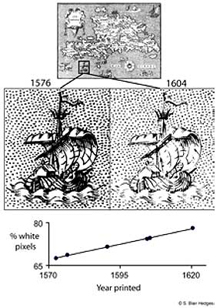Copper Reveals Age of Books, Art
 Close-up of a galleon (ship) from two Renaissance maps made by the same copperplate in 1576 and 1604. Based on these maps and the use of a new method that dates prints based on the thinness of lines on copper plate, a third, previously undated map, was determined to have been printed in 1595.
Close-up of a galleon (ship) from two Renaissance maps made by the same copperplate in 1576 and 1604. Based on these maps and the use of a new method that dates prints based on the thinness of lines on copper plate, a third, previously undated map, was determined to have been printed in 1595.High-resolution version of this photo.
A professor of evolutionary biology at Pennsylvania State University has discovered a potentially revolutionary new way to date rare books, maps and prints. The method, also applied to woodcuts, analyzes the depth and structure of printed lines produced by copper plates used to make artwork.
A variety of documents and reading materials were made using copper plates centuries ago. Because of the plates' cost and availability, they were reused when new prints were required. Over time, mild corrosion affected the plates, which were then polished to remove any imperfections before they were put back into service. The professor researching this subject, Blair Hedges, believes this process gradually eroded the surface of the plates, reducing the amount of ink in the grooves originally etched into the medium. As a result, less ink could be transferred by the grooves, producing paler copies.
The difference in impressions is measurable between earlier and later versions of the same print whose dates are known. Hedges says this deterioration allows researchers to calculate an average annual rate of deterioration for the plate. The lightness of an undated print then can be matched up against a baseline set of plates to determine its age.
Hedges' theory has its detractors. Others believe that the thinner lines found in the later copper plates result from the pressure of the printing presses. However, Hedges counters that pressure would produce wider grooves and lines, not thinner ones.
Industry contemporaries are currently validating the new dating method. "In the next few years, we'll see whether it is generally applicable, but I think it will be," says Hedges. "This is a huge benefit to historians and artists. Millions of books have been printed in this manner and many have no dates. Concepts and discoveries we know to be true today were proposed hundreds of years ago, and it's of interest to many people to know when these ideas were proposed and when society accepted them." Cu
Resources:
Also in this Issue:
- Using Copper for What Ales You
- Copper in Art Through the Ages
- A Library Enhanced by Copper
- Architecture Defined By Copper
- Copper Reveals Age of Books, Art
